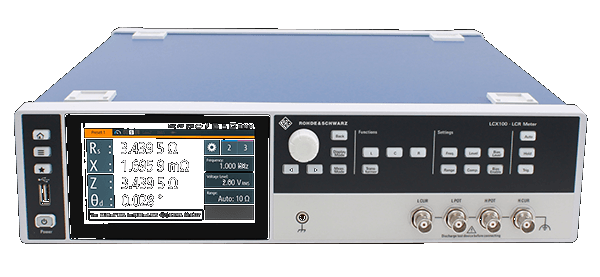Murata Capacitor Review: Evaluating the 100nF GCM155R71C104KA55D in Today's Electronics
By Mark Harris Thursday, 13 April 2023

Introduction
In this technical review, we will be analyzing the performance of Murata Electronics GCM155R71C104KA55D, a capacitor with a nominal value of 100n, tolerance of ±10%, voltage rating of 16V, and a Ceramic: X7R composition. The focus of this evaluation will be to compare component data obtained under various test conditions against the statistical benchmark of other components with the same value.
By assessing parameters like capacitance, series resistance, dissipation factor, and quality factor under different testing scenarios, we aim to assist engineers in understanding this capacitor's suitability for various circuits and applications.
Pros
- Manufactured by Murata Electronics, a globally renowned manufacturer of electronic components
- Surface Mount package for easy integration and compact designs
- Wide operating temperature range for a Ceramic: X7R capacitor
Cons
- Lower quality factor at low-frequency tests compared to high-frequency ones
- Higher dissipation factor, especially at low-frequency tests
- Not suitable for certain high-precision applications due to the variation in the capacitance performance when compared to the statistical benchmark
In the upcoming sections, we will dive deeper into the specific areas of capacitance, series resistance, dissipation factor, and quality factor, providing a comprehensive comparative analysis of the GCM155R71C104KA55D capacitor's performance against the statistical benchmark.
Impedance
In this section, the impedance performance of the GCM155R71C104KA55D capacitor is analyzed and compared to the corresponding statistical benchmark data. This comparison provides valuable insights for electronics engineers considering this capacitor for their circuit designs.
At lower frequencies (5 Hz to 1 kHz), the GCM155R71C104KA55D exhibits impedance values similar to those of the statistical benchmark, with only marginal differences. For example, the capacitor has an impedance of 316.3k Ohms at 5 Hz, slightly higher than the average impedance (313.4k Ohms) for the benchmark. Similarly, at 10 Hz, its impedance stands at 158.6k Ohms, which is again a bit above the statistical average (157.2k Ohms).
When examining higher frequencies, it can be observed that the GCM155R71C104KA55D capacitor generally presents lower impedance values compared to the statistical benchmark. This trend becomes more evident within the frequency range of 50 kHz to 1 MHz. For instance, at 100 kHz, the capacitor has an impedance of 17.41k Ohms, which falls below the average impedance value (18.07k Ohms) for the benchmark. Likewise, at 1 MHz, its impedance is 1.804k Ohms, less than the statistical average (1.958k Ohms).
Concerning the impedance performance at 10 Volts, the GCM155R71C104KA55D capacitor exhibits a similar trend to the values recorded at 1 Volt. Differences between the capacitor and the benchmark are more noticeable above 50 kHz, with the GCM155R71C104KA55D capacitor maintaining a lower impedance than the statistical average.
Overall, the GCM155R71C104KA55D capacitor demonstrates competitive impedance performance in comparison to the statistical benchmark. The comparable values observed at lower frequencies, coupled with the lower impedance values at higher frequencies, may provide an advantage in certain applications. Thus, this capacitor can be considered an attractive choice for electronics engineers and their circuit designs.
Capacitance
The GCM155R71C104KA55D operates within the standard range for capacitance values across most frequencies, exemplifying satisfactory performance. However, it exhibits slightly lower performance compared to the average benchmark at higher frequencies, and this deviation increases with the growth of the frequency. For instance, at 100kHz, the measured capacitance is 91.4nF, while the benchmark average is 88.4nF. At 1MHz, the capacitance value becomes 88.21nF, a bit lower than the benchmark average of 82.53nF.
When subjected to a 10V bias, the GCM155R71C104KA55D displays a similar trend of staying within an acceptable range, despite certain variations surfacing at specific test frequencies such as 5kHz, 10kHz, and 20kHz. In these cases, the capacitance values surpass the average benchmark. A notable instance occurs at 20kHz, where the measured capacitance value is 99.81nF, contrasting with the 94.99nF benchmark. Nevertheless, the performance discrepancy still widens as frequency increases.
Overall, it is essential to consider the unique capacitance behavior of the GCM155R71C104KA55D component at various frequencies. This understanding will allow engineers to make informed decisions regarding its implementation in specific applications that require accurate capacitance values and reliable performance across a range of frequencies.
Series Resistance
In this section, we will meticulously analyze and compare the Murata Electronics GCM155R71C104KA55D Capacitor's Series Resistance (Rs) to the provided statistical benchmark. The comprehensive comparative analysis will examine the Rs performance at both 1 Volt and 10 Volts over various test frequencies, shedding light on the component's performance within these parameters.
At 1 Volt test voltage, the capacitor's Series Resistance remains predominantly below the average and minimum benchmark values for almost the entire frequency range. In the lower frequency bands of 5 Hz and 10 Hz, the capacitor's Rs measurements are 6.37kΩ and 3.12kΩ respectively. Comparatively, the average benchmark Rs values for these frequencies are 8.751kΩ and 4.329kΩ respectively, which indicates that the GCM155R71C104KA55D Capacitor offers lower resistance than the average component at these lower frequencies. This characteristic can provide reduced power dissipation and improve circuit efficiency.
Similarly, at higher frequencies of 50 Hz and above, the GCM155R71C104KA55D maintains its lower resistance performance. In most of the higher frequency spectrum of this test, the capacitor's Rs is consistently below both the average and minimum benchmark Series Resistance values. It is important to note that lower Rs values are generally considered favorable in high-frequency applications, as they can reduce signal attenuation and improve the circuit's frequency response.
At a 10 Volt test voltage, the GCM155R71C104KA55D has a higher series resistance across the majority of the frequency range compared to its 1 Volt counterpart. Nonetheless, its performance still exceeds the average benchmark of other 100nF X7R Ceramic capacitors in some bands. For frequencies of 50 Hz and above, the capacitor's Rs remains below the average benchmark Series Resistance. By diligently reviewing the provided component and benchmark data, the GCM155R71C104KA55D Capacitor demonstrates lower series resistance in a significant portion of the frequency spectrum when compared to benchmark data. This showcases the capacitor's capability to contribute to better overall circuit performance, especially in high-frequency applications.
Dissipation Factor and Quality Factor
When comparing the performance of Murata Electronics' GCM155R71C104KA55D capacitor with the provided benchmark data, it is essential to consider two crucial parameters: the dissipation factor (Df) and the quality factor (Q). These measures are telling of the capacitor's energy dissipation efficiency and its in-circuit performance, respectively.
For the GCM155R71C104KA55D capacitor measured at 1 volt, the dissipation factor ranges from 0.015 to 0.022. This relatively low Df indicates a reduced loss of energy and higher efficiency of the capacitor. At the same voltage, the quality factor varies from 45.14 to 67.38. This range suggests a reasonable capacitor performance within oscillating or resonating circuits, contributing to the stability and integrity of the overall system.
At low frequencies between 5kHz and 20kHz, the Df remains fairly consistent, lying between 0.020 and 0.019. Correspondingly, a higher Q of around 50 is achieved at these frequencies, while Q peaks at 67.38 within the 200kHz frequency range.
When the measurements are conducted at 10 volts, the dissipation factor of the GCM155R71C104KA55D capacitor exhibits a broader range from 0.026 to 0.053. This suggests an increased energy dissipation and a potential reduction in capacitor efficiency at higher operating voltage levels. The quality factor at 10 volts also displays a lower average, ranging from 18.94 to 39.88. The Q-factor peaks at 39.88 within the 600kHz frequency range, a considerably lower value than the peak Q observed at 1-volt measurements.
In conclusion, the GCM155R71C104KA55D capacitor's performance concerning the dissipation factor and quality factor are integral to understanding its efficiency and in-circuit capabilities. The given data highlights the importance of taking into account different operating voltage levels and frequency ranges while evaluating this capacitor, as its performance tends to fluctuate across these varying conditions.
Comparative Analysis
The Murata Electronics GCM155R71C104KA55D Capacitor has a nominal value of 100n, tolerance of ±10%, voltage rating of 16V, and a composition of Ceramic: X7R. The Capacitor is designed to be surface mounted, featuring a package of 0402 (1005 Metric) which is ideal for integration in compact circuits with space constraints.
When analyzing the performance of the GCM155R71C104KA55D Capacitor in comparison to the statistical benchmark, it's evident that the impedance at 1 Volt varies across multiple test frequencies. For instance, at the lower end, 5 Hz, the Capacitor demonstrates a higher impedance of 316.3k Ohms as compared to the benchmark minimum, average, and maximum values of 278k Ohms, 313.4k Ohms, and 345.9k Ohms respectively. As the test frequency increases, the difference between the component Capacitor's impedance and the benchmark data reduces progressively, making it an ideal choice for a wide range of applications. At the test frequency of 50 kHz, the impedance value for GCM155R71C104KA55D is 34.19 Ohms which falls within the benchmark minimum and maximum impedance range of 32.02 Ohms and 41.46 Ohms respectively.
Similar trends can be observed for other parameters like Dissipation Factor and Quality Factor. Considering the GCM155R71C104KA55D Capacitor's performance at a test frequency of 5 Hz, the Capacitor showcases a Dissipation Factor of 0.020 which is within the range provided by the statistical benchmark- the minimum value being 0.01 and the maximum being 0.07. Further, at this test frequency, its Quality Factor is 49.61; it is within the benchmark range of 13.71 to 101.35.
Moreover, comparing measurements obtained with a higher signal voltage of 10 Volts indicates that the performance of the GCM155R71C104KA55D is consistent and can handle a wider range of voltage operations. At a test frequency of 5 Hz, the recorded impedance value is 312.8k Ohms, with a Dissipation Factor of 0.053 and a Quality Factor of 18.98. Although the impedance and Quality Factor are affected by the signal voltage, they deviate minimally from desirable levels, rendering the GCM155R71C104KA55D a suitable component for designs operating at an elevated voltage.
In conclusion, the GCM155R71C104KA55D Capacitor provides a performance that is in line with the statistical benchmark values across multiple test frequencies, proving to be suitable for its intended Ceramic: X7R applications, offering versatility to engineers assessing this capacitor for use in their circuits. The comparison reveals performance consistency and reliability, making the GCM155R71C104KA55D Capacitor an excellent choice for a wide range of electronic designs.
Conclusion
Upon analyzing the performance of the Murata Electronics GCM155R71C104KA55D Ceramic: X7R capacitor and comparing it to the provided statistical benchmark data, this capacitor demonstrates moderate performance in comparison to other components of the same value.
When evaluating the capacitor's performance at a voltage of 1V, the Impedance and Series Resistance measurements fall within the average range observed in the benchmark data across various test frequencies. The Dissipation Factor for the GCM155R71C104KA55D capacitor is consistent, and in most cases lower, than the average Dissipation Factor of the benchmark across the test frequencies indicating that the capacitor exhibits relatively low dielectric losses.
However, at 10 volts testing, the GCM155R71C104KA55D capacitor's Dissipation Factor tends to be higher than its counterpart at 1 volts testing, indicating an increased dielectric loss in comparison. Still, this may be an acceptable deviation depending on the specific application. It is also worth mentioning that the Quality Factor is relatively lower across the test frequencies, suggesting that this capacitor may not be the optimal choice for applications demanding high-Q performance.
In summary, the Murata Electronics GCM155R71C104KA55D Ceramic: X7R capacitor offers a reasonable Industry-average performance for various applications. However, careful consideration of the capacitor's Dissipation Factor and Quality Factor is advised while assessing its suitability in a particular circuit as it has a lower Quality Factor compared to the average component in the benchmark data.
Instruments Used
Rohde & Schwarz LCX200



